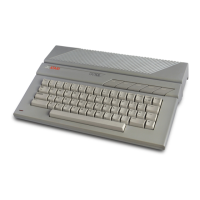60
PRINT
"NOTES
FOR
SIMPLE
SONG"
65
FOR
NOTE=
1.
TO
8
70
READ
PITCH
80
SOUND
UOICE
..
PITCH
..
TONE
..
UOL
'30
GOSUB
200
1.00
PRINT:
PRINT
PITCH$
1.1.0
FOR
PAUSE=1.
TO
500:
NEXT
PAUSE
1.20
SOUND
0
..
0
..
0
..
0
1.30
NEXT
NOTE
1.40
GOTO
300
1.50
REM
**
DATA
FOR
NOTES
1.60
DATA
1.21.
..
1.21.
..
1.08
..
'36
..
'36
..
'31.
..
1.08
..
1.21.
200
REM
**
PRINT
NOTES
21.0
IF
PITCH=1.21.
THEN
PITCH$="C"
220
IF
PITCH=1.08
THEN
PITCH$="
D"
230
IF
PITCH='36
THEN
PITCH$="E"
240
IF
PITCH='31.
THEN
PITCH$="
F"
250
RE
·
TURN
300
PRINT:
PRINT"
END
OF
SIMPLE
SONG"
:
END
RUN
The GOSUB-RETURN and READ-DATA commands allow the computer
to produce different notes
by
inserting a series of values for the
variable
PITCH
. GOSUB tells the computer to go to the
"subroutine"
that starts at line 200 and continues to line 250; the RETURN com-
mand sends the computer back to the line immediately below the
GOSUB line. The READ command tells the computer to pick up
an
item
in
the DATA line and insert it into the variable. The computer con-
tinues to loop through the program until all the values
in
the DATA line
have been
'used.
The program also uses a FOR-NEXT loop to determine how long the
notes last. Using different
FOR-N
EXT loops, try modifying the program
to produce whole notes, half notes, and other kinds of notes.
For more information about programming with sound, refer to the
Resources section of this guide.
COLORFUL GRAPHICS
Your
ATARI
130XE has 16 graphics modes encompassing 256 colors.
To
get you started, this section presents 6 different modes and some
of the most essential graphics commands.
The following chart lists the
16
basic colors and their corresponding
number values.
(The
colors
va
ry
somewhat according to the adjust-
ment of the hue control
on
your television set.)
68

